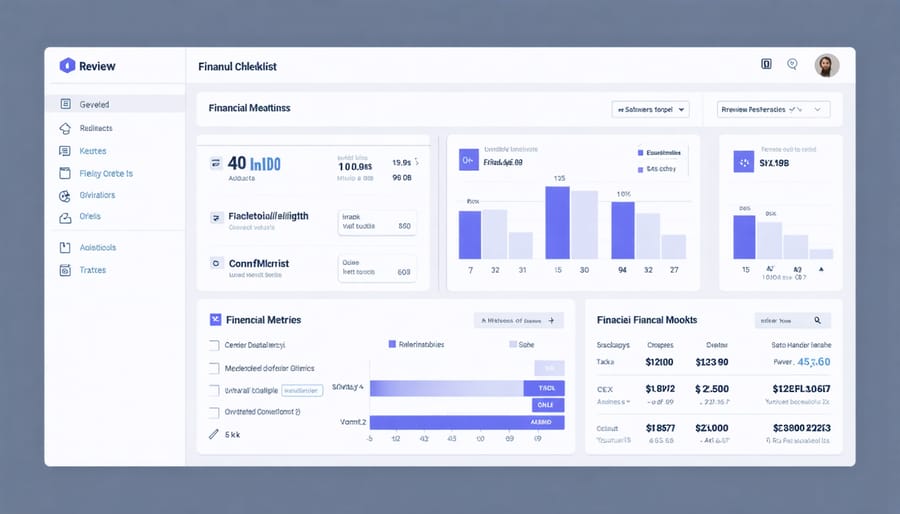Transform your financial future with six strategic steps that blend real estate investments, tax optimization, and wealth protection. Today’s dynamic market demands a sophisticated approach to financial planning – one that goes beyond basic budgeting and savings. Whether you’re a seasoned real estate professional or building your first investment portfolio, mastering these essential financial planning steps will help you create lasting wealth while minimizing risk.
Smart financial planning isn’t just about growing your money; it’s about building a comprehensive framework that protects your assets, optimizes tax efficiency, and creates multiple streams of income. In the following guide, you’ll discover how to integrate property investments, insurance strategies, and tax planning into a cohesive financial strategy that works for both immediate gains and long-term security.
The difference between financial success and stagnation often lies in the execution of these fundamental steps. Let’s dive into the six critical financial planning actions that successful investors and real estate professionals use to build and protect their wealth.
1. Assess Your Current Financial Position

Creating Your Financial Snapshot
Begin by gathering all your financial documents – bank statements, investment portfolios, property deeds, and insurance policies. Create a comprehensive list of your assets, including your primary residence, rental properties, and any other real estate investments. Don’t forget to include their current market values and any outstanding mortgages or liens.
Next, document your income sources, whether it’s rental income, salary, or investment returns. Be thorough in listing your monthly expenses, including property maintenance costs, insurance premiums, and mortgage payments. This creates a clear picture of your cash flow situation.
Pay special attention to your real estate portfolio’s performance. Calculate the ROI on each property, factoring in appreciation, rental income, and operating expenses. Include any property tax obligations and insurance costs in your calculations.
Review your credit report and score, as these will impact your ability to secure future real estate financing. Finally, create a balance sheet that shows your net worth – the difference between your total assets and liabilities. This snapshot becomes your baseline for measuring financial progress and making informed investment decisions.
Keep this document updated quarterly to track your financial health and adjust your strategy as needed.
Identifying Financial Strengths and Gaps
Begin by taking a comprehensive inventory of your financial landscape, including all assets, liabilities, and income streams. This crucial step helps identify your current financial position and reveals both strengths to leverage and gaps to address. Pay particular attention to your real estate holdings, as these often represent significant assets in your portfolio.
List your income sources, including rental properties, investments, and primary employment. Then, evaluate your expenses and debt obligations. Understanding your cash flow patterns and managing your debts effectively is essential for building a strong financial foundation.
Look for areas where you’re excelling, such as maintaining a healthy emergency fund or building equity in your properties. Equally important is identifying weaknesses that need attention, such as insufficient insurance coverage or gaps in your retirement planning. Consider factors like property market trends, interest rates, and potential investment opportunities that align with your goals.
Common gaps often include inadequate emergency savings, insufficient insurance coverage, or an imbalanced investment portfolio. By identifying these areas early, you can develop targeted strategies to strengthen your financial position and protect your real estate investments.
2. Set Clear Financial Goals
Short-term vs. Long-term Planning
Successful financial planning requires striking a delicate balance between immediate needs and long-term goals. While it’s crucial to address current expenses like mortgage payments, property maintenance, and insurance premiums, you shouldn’t lose sight of future aspirations such as property investments or retirement planning.
Start by allocating your resources between short-term emergency funds (covering 3-6 months of expenses) and long-term investment vehicles. For real estate professionals and property investors, this might mean maintaining liquid assets for unexpected property repairs while simultaneously investing in market opportunities that offer potential appreciation.
Consider creating a two-tier planning system: one for immediate financial obligations and another for future wealth-building strategies. This approach helps prevent the common mistake of sacrificing long-term financial security for short-term convenience. Remember, successful real estate investors often maintain multiple timelines, balancing quick-flip opportunities with extended hold periods for maximum returns.
Property Investment Objectives
Establishing clear property investment objectives is crucial for long-term financial success. Start by defining your primary investment goals – whether that’s generating passive rental income, building equity for retirement, or capitalizing on property appreciation. Consider setting SMART goals: Specific property types you’re interested in, Measurable returns you expect, Achievable investment targets based on your budget, Relevant opportunities in your target market, and Time-bound milestones for acquisition and returns.
Factor in your risk tolerance and investment horizon when setting these objectives. For instance, if you’re planning for retirement, you might focus on stable, long-term appreciation rather than quick flips. Calculate your desired return on investment (ROI), including both rental yields and potential capital gains. Set benchmarks for key metrics like cash flow, vacancy rates, and maintenance costs.
Remember to align these property investment goals with your broader financial planning strategy, ensuring they complement other investments and financial commitments.
3. Create Your Protection Strategy
Property Insurance Essentials
Property insurance is a critical component of protecting your real estate investments. At its core, you’ll need comprehensive homeowners insurance that covers both structural damage and personal belongings. This policy should include dwelling coverage, personal property protection, and liability insurance to safeguard against potential lawsuits.
Consider additional coverage options based on your property’s location and specific risks. Flood insurance is essential in flood-prone areas, as standard policies typically don’t cover flood damage. Similarly, earthquake coverage might be necessary in seismically active regions. If you’re in areas prone to hurricanes or severe storms, windstorm insurance could be crucial.
For investment properties, landlord insurance provides specialized coverage beyond standard homeowners insurance, protecting rental income and covering liability specific to tenant occupancy. Don’t forget to regularly review and update your coverage limits to account for property improvements, rising construction costs, and changing market values.
Insurance riders can extend protection for high-value items like jewelry or art collections kept on the property. Remember to document all your possessions with photos and maintain detailed records of improvements to facilitate potential claims.
Personal Financial Protection
Insurance protection forms the cornerstone of a solid financial plan, especially for real estate professionals and property owners. Start with comprehensive life insurance to protect your property legacy and ensure your family’s financial security. Consider both term and permanent policies based on your long-term goals and investment portfolio.
Disability insurance is equally crucial, particularly for real estate professionals whose income depends on their ability to work. A robust disability policy should cover at least 60-70% of your current income, ensuring you can maintain your lifestyle and property investments if you’re unable to work.
Liability insurance provides an essential safety net against potential lawsuits and financial damages. For property owners, consider an umbrella policy that extends beyond standard homeowner’s coverage. This additional layer of protection is particularly valuable if you own multiple properties or operate a real estate business.
Review your insurance coverage annually and adjust as your portfolio grows. Remember that insurance needs evolve with life changes, property acquisitions, and market conditions. Work with an experienced insurance advisor who understands the unique needs of real estate professionals and can recommend appropriate coverage levels.
4. Optimize Your Tax Position
Real Estate Tax Benefits
Real estate ownership offers substantial tax advantages that can significantly impact your financial planning strategy. Understanding these benefits is crucial for maximizing your investment returns. One of the most notable advantages is the mortgage interest deduction, allowing homeowners to deduct interest payments from their taxable income. Additionally, property tax payments are typically deductible, providing another avenue for tax savings.
For real estate investors, there are numerous tax deductions for real estate investors that can help optimize returns. These include depreciation allowances, which let you deduct the cost of property improvements over time, and operating expenses such as maintenance, insurance, and utilities.
Capital gains tax benefits are particularly attractive when selling your primary residence. The IRS allows couples to exclude up to $500,000 ($250,000 for single filers) of profit from capital gains taxes, provided certain conditions are met. Real estate investors can also take advantage of 1031 exchanges, allowing them to defer capital gains taxes by reinvesting proceeds into similar properties.
To maximize these benefits, consider consulting with a tax professional who specializes in real estate. They can help structure your investments and transactions to optimize tax efficiency while ensuring compliance with current regulations.
Tax-Efficient Investment Strategies
Tax efficiency can significantly impact your long-term wealth accumulation, especially in real estate investments. One powerful strategy is maximizing contributions to tax-advantaged retirement accounts like 401(k)s and IRAs before exploring other investment options. For real estate professionals, establishing a self-employed retirement plan can offer additional tax benefits and higher contribution limits.
Consider tax-loss harvesting in your investment portfolio, where you offset capital gains by selling investments at a loss. This strategy works particularly well when balanced with real estate investments, which offer numerous tax advantages through depreciation and mortgage interest deductions.
Real estate investors should explore opportunities in Qualified Opportunity Zones, which provide capital gains tax benefits while supporting community development. Additionally, 1031 exchanges allow you to defer capital gains taxes when selling investment properties by reinvesting in like-kind properties.
Municipal bonds can provide tax-free income at the federal level and potentially at the state level, depending on your residence. For those in higher tax brackets, these investments can offer competitive after-tax returns compared to taxable alternatives.
Remember to work with a qualified tax professional who understands both real estate and investment taxation to create a comprehensive strategy that aligns with your financial goals while minimizing tax liability.
5. Build Your Investment Portfolio
Asset Allocation Principles
A well-balanced investment portfolio is crucial for financial stability, and real estate often plays a significant role in this mix. While property can be a valuable investment, it’s essential to avoid putting all your eggs in one basket. Making smart property investment decisions requires careful consideration of how real estate fits into your overall financial picture.
Consider following the 5-30-35 rule: maintain 5% in cash reserves, allocate up to 30% of your portfolio to real estate investments, and diversify the remaining 35% across stocks, bonds, and other investment vehicles. This approach helps protect against market volatility while maximizing potential returns.
When balancing your portfolio, factor in your primary residence’s value, rental properties, REITs, and other real estate investments. Remember that property investments typically offer benefits like rental income and potential appreciation but can be less liquid than other assets. Consider your age, risk tolerance, and financial goals when determining the right mix. Regular portfolio rebalancing ensures your asset allocation remains aligned with your long-term objectives while maintaining a healthy risk-reward ratio.

Risk Management Through Diversification
The old saying “don’t put all your eggs in one basket” perfectly captures the essence of risk management through diversification. In today’s dynamic financial landscape, spreading your investments across different asset classes is crucial for protecting and growing your wealth. A well-balanced portfolio typically includes a mix of real estate investments, stocks, bonds, and cash equivalents.
For real estate professionals and investors, this might mean diversifying beyond residential properties into commercial real estate, REITs, or real estate-focused mutual funds. Consider allocating your investments across different geographic locations and property types to minimize market-specific risks.
Beyond real estate, explore other investment vehicles that complement your property holdings. This could include dividend-paying stocks, government bonds, or certificates of deposit (CDs). The key is maintaining an asset allocation that aligns with your risk tolerance and investment timeline.
Remember to regularly review and rebalance your portfolio. Market fluctuations can shift your asset allocation away from your target percentages, potentially exposing you to more risk than intended. Aim to reassess your diversification strategy at least annually or when significant market changes occur.
6. Regular Review and Adjustment

Quarterly Financial Checkups
Schedule quarterly financial reviews to stay on top of your financial goals and make necessary adjustments. These checkups should include reviewing your real estate investments, insurance coverage, and overall portfolio performance. Compare your actual spending against your budget, assess your debt management progress, and evaluate whether your investment strategy needs tweaking. Pay special attention to market changes that might affect your property investments and insurance needs. Use this time to update your financial documents, review your tax planning strategy, and ensure you’re on track with your savings goals. If needed, consult with financial advisors or real estate professionals to get expert insights on market trends and opportunities. Remember, regular monitoring helps you spot potential issues early and keeps your financial plan aligned with your long-term objectives.
When to Seek Professional Advice
While basic financial planning can be managed independently, certain situations warrant professional guidance. Consider consulting a financial advisor when facing complex real estate investments, significant life changes like marriage or retirement, or when your investment portfolio exceeds $250,000. Estate planning, tax optimization strategies, and insurance coverage decisions also benefit from expert input. Look for certified professionals with experience in real estate and investment planning, and don’t hesitate to seek a second opinion for major financial decisions. Regular check-ins with financial professionals can help you stay on track and adjust your strategy as market conditions and personal circumstances evolve.
Taking control of your financial future doesn’t have to be overwhelming when you break it down into these six manageable steps. From establishing clear financial goals and creating a robust budget to building your emergency fund and maximizing tax efficiency, each step builds upon the previous one to create a solid financial foundation. Remember to regularly review and adjust your insurance coverage and retirement planning strategies as your circumstances change. Your financial journey is unique to you, and these steps can be customized to fit your specific needs and goals. Don’t wait to start implementing these strategies – even small actions today can lead to significant financial security tomorrow. Take the first step now by reviewing your current financial situation and begin working through these steps systematically.